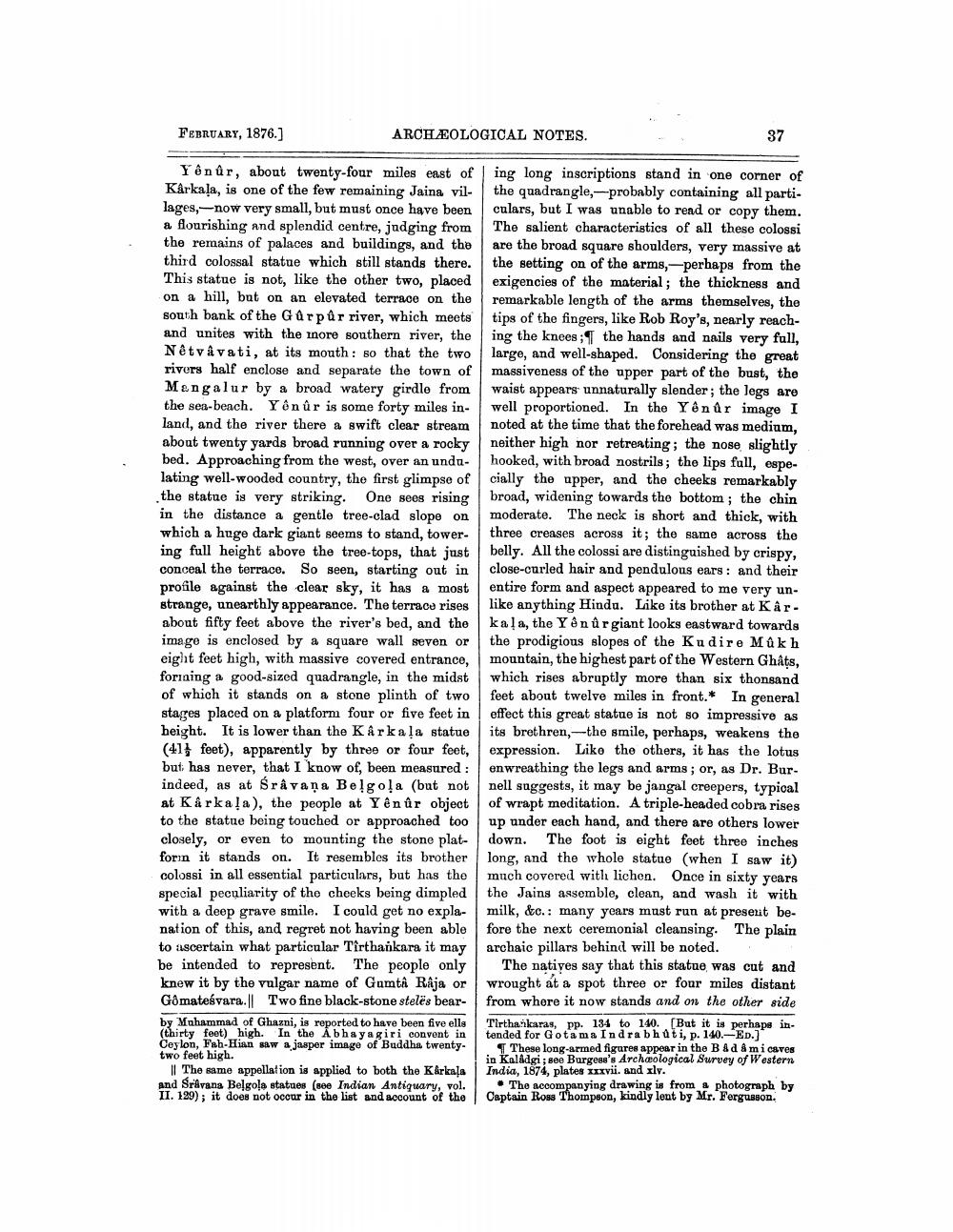________________
FEBRUARY, 1876.]
ARCHÆOLOGICAL NOTES.
37
Yênûr, about twenty-four miles east of Karkala, is one of the few remaining Jaina villages,-now very small, but must once have been a flourishing and splendid centre, judging from the remains of palaces and buildings, and the third colossal statue which still stands there. This statue is not, like the other two, placed on a hill, but on an elevated terrace on the south bank of the Gurpûr river, which meets and unites with the inore southern river, the Nêtvå vati, at its mouth : so that the two rivors half enclose and separate the town of Mangalur by a broad watery girdlo from the sea-beach. Yên ûr is some forty miles in land, and the river there a swift clear stream about twenty yards broad running over a rocky bed. Approaching from the west, over an undulating well-wooded country, the first glimpse of the statue is very striking. One sees rising in the distance a gentle tree-clad slope on which a huge dark giant seems to stand, tower ing full height above the tree-tops, that just conceal the terrace. So seen, starting out in profile against the clear sky, it has a most strange, unearthly appearance. The terrace rises about fifty feet above the river's bed, and the image is enclosed by a square wall seven or eight feet high, with massive covered entrance, forraing a good-sized quadrangle, in the midst of which it stands on a stone plinth of two stages placed on a platform four or five feet in height. It is lower than the Karkala statue (41 feet)apparently by three or four feet, but has never, that I know of, been measured : indeed, as at Sravana Belgola (but not at Kårkala), the people at Yênûr object to the statue being touched or approached too closely, or even to mounting the stone plat- forin it stands on. It resembles its brother colossi in all essential particulars, but has the special peculiarity of the cheeks being dimpled with a deep grave smile. I could get no explanation of this, and regret not having been able to ascertain what particular Tirthankara it may be intended to represent. The people only knew it by the vulgar name of Gumtâ Raja or Gômateśvara.|| Two fine black-stone stelës bearby Muhammad of Ghazni, is reported to have been five ells (thirty feet) high. In the Abhayagiri convent in Ceylon, Fab-Hian saw a jasper image of Buddha twentytwo feet high.
|| The same appellation is applied to both the Karkala And Sravana Beļgolo statues (nee Indian Antiquary, vol. II. 129), it does not cour in the list and account of the
ing long inscriptions stand in one corner of the quadrangle,--probably containing all parti. culars, but I was unable to read or copy them. The salient characteristics of all these colossi are the broad square shoulders, very massive at the setting on of the arms,-perhaps from the exigencies of the material; the thickness and remarkable length of the arms themselves, the tips of the fingers, like Rob Roy's, nearly reaching the knees; the hands and nails very full, large, and well-shaped. Considering the great massiveness of the upper part of the bust, the waist appears unnaturally slender; the legs are well proportioned. In the Yênur image I noted at the time that the forehead was medium, neither high nor retreating; the nose slightly hooked, with broad nostrils; the lips fall, especially the upper, and the cheeks remarkably broad, widening towards the bottom; the chin moderate. The neck is short and thick, with three creases across it; the same across the belly. All the colossi are distinguished by crispy, close-curled hair and pendulous ears: and their entire form and aspect appeared to me very unlike anything Hindu. Like its brother at Kârkala, the Yên ùrgiant looks eastward towards the prodigious slopes of the Kudire Mûk h mountain, the highest part of the Western Ghats, which rises abruptly more than six thonsand feet about twelve miles in front.* In general effect this great statue is not so impressive as its brethren,--the smile, perhaps, weakens the expression. Liko the others, it has the lotus enwreathing the legs and arms; or, as Dr. Bur. nell suggests, it may be jangal creepers, typical of wrapt meditation. A triple-headed cobra rises up under each hand, and there are others lower down. The foot is eight feet three inches long, and the whole statue (when I saw it) much covered with lichen. Once in sixty years the Jains assemble, clean, and wash it with milk, &c.: many years must run at present before the next ceremonial cleansing. The plain archaic pillars behind will be noted.
The natiyes say that this statue was cut and wrought at a spot three or four miles distant from where it now stands and on the other side Tirthankaras, pp. 134 to 140. (But it is perhaps intended for Gotama Indrabhati, p. 140.-ED.
These long-armed figures appear in the Bad & mi caves in Kalådgi; Bee Burgess's Archaeological Survey of Western India, 1874, plates xxxvii. and xlv.
• The accompanying drawing is from a photograph by Captain Ron Thompson, kindly lout by Mr. Ferguson.




